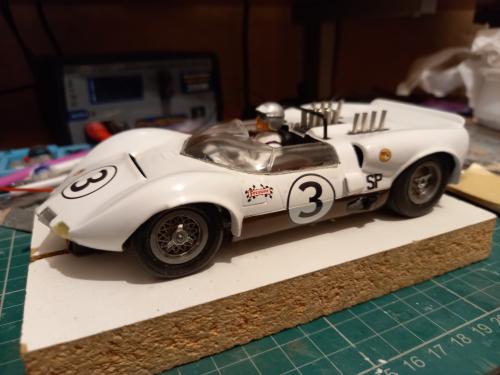4th-Jun-21, 11:33 AM
These two were pretty battered when I got them. I have been working on them on and off for about 18 months.
The Chaparral had cut arches, no rear lights, no exhausts, only the flat plate for the intake trumpets, and the area around the front lights was a mass of old glue.
The Lotus had no roll bar or rear lights and one of the vents on rear deck had been melted under a layer of glue. The screen was rough and the headlight covers were beyond saving.
The Chaparral screen broke while I was trying to clean it up so I bought screens and light covers for both cars from Brad Blohm but in the end decided to rescue the original Lotus screen and I scratchbuilt the other missing bits as best I could.
I got my research wrong and painted the Lotus wheels yellow but I will sort this out later.
They aren't immaculate but are good enough for our vintage 36D class.



The Chaparral had cut arches, no rear lights, no exhausts, only the flat plate for the intake trumpets, and the area around the front lights was a mass of old glue.
The Lotus had no roll bar or rear lights and one of the vents on rear deck had been melted under a layer of glue. The screen was rough and the headlight covers were beyond saving.
The Chaparral screen broke while I was trying to clean it up so I bought screens and light covers for both cars from Brad Blohm but in the end decided to rescue the original Lotus screen and I scratchbuilt the other missing bits as best I could.
I got my research wrong and painted the Lotus wheels yellow but I will sort this out later.
They aren't immaculate but are good enough for our vintage 36D class.

![[+]](https://slotracer.online/community/images/bootbb/collapse_collapsed.png)
![[Image: DSCN4134-copy.jpg]](https://i.postimg.cc/q734yYHw/DSCN4134-copy.jpg)
![[Image: DSCN4143-copy.jpg]](https://i.postimg.cc/gjNWGb3z/DSCN4143-copy.jpg)
![[Image: DSCN4133-copy.jpg]](https://i.postimg.cc/mgqTc4Jh/DSCN4133-copy.jpg)
![[Image: DSCN4149-copy.jpg]](https://i.postimg.cc/pVqbhxnx/DSCN4149-copy.jpg)
![[Image: 2003-12-31-23-00-00-31-copy.jpg]](https://i.postimg.cc/PJG4NCzK/2003-12-31-23-00-00-31-copy.jpg)
![[Image: 2003-12-31-23-00-00-79-copy.jpg]](https://i.postimg.cc/zXFjXXLS/2003-12-31-23-00-00-79-copy.jpg)
